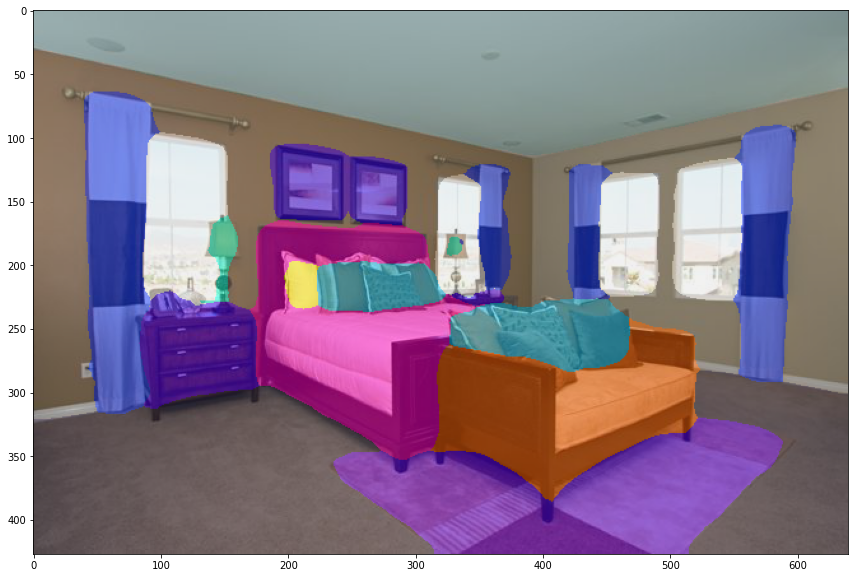Semantic segmentation
セマンティック セグメンテーションでは、画像の個々のピクセルにラベルまたはクラスを割り当てます。セグメンテーションにはいくつかのタイプがありますが、セマンティック セグメンテーションの場合、同じオブジェクトの一意のインスタンス間の区別は行われません。両方のオブジェクトに同じラベルが付けられます (たとえば、car-1とcar-2の代わりにcar)。セマンティック セグメンテーションの一般的な現実世界のアプリケーションには、歩行者や重要な交通情報を識別するための自動運転車のトレーニング、医療画像内の細胞と異常の識別、衛星画像からの環境変化の監視などが含まれます。
このガイドでは、次の方法を説明します。
- SceneParse150 データセットの SegFormer を微調整します。
- 微調整したモデルを推論に使用します。
このタスクと互換性のあるすべてのアーキテクチャとチェックポイントを確認するには、タスクページ を確認することをお勧めします。
始める前に、必要なライブラリがすべてインストールされていることを確認してください。
pip install -q datasets transformers evaluate
モデルをアップロードしてコミュニティと共有できるように、Hugging Face アカウントにログインすることをお勧めします。プロンプトが表示されたら、トークンを入力してログインします。
>>> from huggingface_hub import notebook_login
>>> notebook_login()Load SceneParse150 dataset
まず、SceneParse150 データセットの小さいサブセットを 🤗 データセット ライブラリから読み込みます。これにより、完全なデータセットのトレーニングにさらに時間を費やす前に、実験してすべてが機能することを確認する機会が得られます。
>>> from datasets import load_dataset
>>> ds = load_dataset("scene_parse_150", split="train[:50]")train_test_split メソッドを使用して、データセットの train 分割をトレイン セットとテスト セットに分割します。
>>> ds = ds.train_test_split(test_size=0.2)
>>> train_ds = ds["train"]
>>> test_ds = ds["test"]次に、例を見てみましょう。
>>> train_ds[0]
{'image': <PIL.JpegImagePlugin.JpegImageFile image mode=RGB size=512x683 at 0x7F9B0C201F90>,
'annotation': <PIL.PngImagePlugin.PngImageFile image mode=L size=512x683 at 0x7F9B0C201DD0>,
'scene_category': 368}image: シーンの PIL イメージ。annotation: セグメンテーション マップの PIL イメージ。モデルのターゲットでもあります。scene_category: “kitchen”や”office”などの画像シーンを説明するカテゴリ ID。このガイドでは、imageとannotationのみが必要になります。どちらも PIL イメージです。
また、ラベル ID をラベル クラスにマップする辞書を作成することもできます。これは、後でモデルを設定するときに役立ちます。ハブからマッピングをダウンロードし、id2label および label2id ディクショナリを作成します。
>>> import json
>>> from pathlib import Path
>>> from huggingface_hub import hf_hub_download
>>> repo_id = "huggingface/label-files"
>>> filename = "ade20k-id2label.json"
>>> id2label = json.loads(Path(hf_hub_download(repo_id, filename, repo_type="dataset")).read_text())
>>> id2label = {int(k): v for k, v in id2label.items()}
>>> label2id = {v: k for k, v in id2label.items()}
>>> num_labels = len(id2label)Preprocess
次のステップでは、SegFormer 画像プロセッサをロードして、モデルの画像と注釈を準備します。このデータセットのような一部のデータセットは、バックグラウンド クラスとしてゼロインデックスを使用します。ただし、実際には背景クラスは 150 個のクラスに含まれていないため、do_reduce_labels=Trueを設定してすべてのラベルから 1 つを引く必要があります。ゼロインデックスは 255 に置き換えられるため、SegFormer の損失関数によって無視されます。
>>> from transformers import AutoImageProcessor
>>> checkpoint = "nvidia/mit-b0"
>>> image_processor = AutoImageProcessor.from_pretrained(checkpoint, do_reduce_labels=True)モデルを過学習に対してより堅牢にするために、画像データセットにいくつかのデータ拡張を適用するのが一般的です。このガイドでは、torchvision の ColorJitter 関数を使用します。 ) を使用して画像の色のプロパティをランダムに変更しますが、任意の画像ライブラリを使用することもできます。
>>> from torchvision.transforms import ColorJitter
>>> jitter = ColorJitter(brightness=0.25, contrast=0.25, saturation=0.25, hue=0.1)次に、モデルの画像と注釈を準備するための 2 つの前処理関数を作成します。これらの関数は、画像をpixel_valuesに変換し、注釈をlabelsに変換します。トレーニング セットの場合、画像を画像プロセッサに提供する前に jitter が適用されます。テスト セットの場合、テスト中にデータ拡張が適用されないため、画像プロセッサはimagesを切り取って正規化し、ラベルのみを切り取ります。
>>> def train_transforms(example_batch):
... images = [jitter(x) for x in example_batch["image"]]
... labels = [x for x in example_batch["annotation"]]
... inputs = image_processor(images, labels)
... return inputs
>>> def val_transforms(example_batch):
... images = [x for x in example_batch["image"]]
... labels = [x for x in example_batch["annotation"]]
... inputs = image_processor(images, labels)
... return inputsデータセット全体にjitterを適用するには、🤗 Datasets set_transform 関数を使用します。変換はオンザフライで適用されるため、高速で消費するディスク容量が少なくなります。
>>> train_ds.set_transform(train_transforms)
>>> test_ds.set_transform(val_transforms)モデルを過学習に対してより堅牢にするために、画像データセットにいくつかのデータ拡張を適用するのが一般的です。
このガイドでは、tf.image を使用して画像の色のプロパティをランダムに変更しますが、任意のプロパティを使用することもできます。画像
好きな図書館。
2 つの別々の変換関数を定義します。
- 画像拡張を含むトレーニング データ変換
- 🤗 Transformers のコンピューター ビジョン モデルはチャネル優先のレイアウトを想定しているため、画像を転置するだけの検証データ変換
>>> import tensorflow as tf
>>> def aug_transforms(image):
... image = tf.keras.utils.img_to_array(image)
... image = tf.image.random_brightness(image, 0.25)
... image = tf.image.random_contrast(image, 0.5, 2.0)
... image = tf.image.random_saturation(image, 0.75, 1.25)
... image = tf.image.random_hue(image, 0.1)
... image = tf.transpose(image, (2, 0, 1))
... return image
>>> def transforms(image):
... image = tf.keras.utils.img_to_array(image)
... image = tf.transpose(image, (2, 0, 1))
... return image次に、モデルの画像と注釈のバッチを準備する 2 つの前処理関数を作成します。これらの機能が適用されます
画像変換を行い、以前にロードされた image_processor を使用して画像を pixel_values に変換し、
labelsへの注釈。 ImageProcessor は、画像のサイズ変更と正規化も処理します。
>>> def train_transforms(example_batch):
... images = [aug_transforms(x.convert("RGB")) for x in example_batch["image"]]
... labels = [x for x in example_batch["annotation"]]
... inputs = image_processor(images, labels)
... return inputs
>>> def val_transforms(example_batch):
... images = [transforms(x.convert("RGB")) for x in example_batch["image"]]
... labels = [x for x in example_batch["annotation"]]
... inputs = image_processor(images, labels)
... return inputsデータセット全体に前処理変換を適用するには、🤗 Datasets set_transform 関数を使用します。
変換はオンザフライで適用されるため、高速で消費するディスク容量が少なくなります。
>>> train_ds.set_transform(train_transforms)
>>> test_ds.set_transform(val_transforms)Evaluate
トレーニング中にメトリクスを含めると、多くの場合、モデルのパフォーマンスを評価するのに役立ちます。 🤗 Evaluate ライブラリを使用して、評価メソッドをすばやくロードできます。このタスクでは、Mean Intersection over Union (IoU) メトリックをロードします (🤗 Evaluate クイック ツアー を参照して、メトリクスをロードして計算する方法の詳細を確認してください)。
>>> import evaluate
>>> metric = evaluate.load("mean_iou")次に、メトリクスを compute する関数を作成します。予測を次のように変換する必要があります
最初にロジットを作成し、次に compute を呼び出す前にラベルのサイズに一致するように再形成します。
>>> import numpy as np
>>> import torch
>>> from torch import nn
>>> def compute_metrics(eval_pred):
... with torch.no_grad():
... logits, labels = eval_pred
... logits_tensor = torch.from_numpy(logits)
... logits_tensor = nn.functional.interpolate(
... logits_tensor,
... size=labels.shape[-2:],
... mode="bilinear",
... align_corners=False,
... ).argmax(dim=1)
... pred_labels = logits_tensor.detach().cpu().numpy()
... metrics = metric.compute(
... predictions=pred_labels,
... references=labels,
... num_labels=num_labels,
... ignore_index=255,
... reduce_labels=False,
... )
... for key, value in metrics.items():
... if type(value) is np.ndarray:
... metrics[key] = value.tolist()
... return metrics>>> def compute_metrics(eval_pred):
... logits, labels = eval_pred
... logits = tf.transpose(logits, perm=[0, 2, 3, 1])
... logits_resized = tf.image.resize(
... logits,
... size=tf.shape(labels)[1:],
... method="bilinear",
... )
... pred_labels = tf.argmax(logits_resized, axis=-1)
... metrics = metric.compute(
... predictions=pred_labels,
... references=labels,
... num_labels=num_labels,
... ignore_index=-1,
... reduce_labels=image_processor.do_reduce_labels,
... )
... per_category_accuracy = metrics.pop("per_category_accuracy").tolist()
... per_category_iou = metrics.pop("per_category_iou").tolist()
... metrics.update({f"accuracy_{id2label[i]}": v for i, v in enumerate(per_category_accuracy)})
... metrics.update({f"iou_{id2label[i]}": v for i, v in enumerate(per_category_iou)})
... return {"val_" + k: v for k, v in metrics.items()}これでcompute_metrics関数の準備が整いました。トレーニングをセットアップするときにこの関数に戻ります。
Train
これでモデルのトレーニングを開始する準備が整いました。 AutoModelForSemanticSegmentation を使用して SegFormer をロードし、ラベル ID とラベル クラス間のマッピングをモデルに渡します。
>>> from transformers import AutoModelForSemanticSegmentation, TrainingArguments, Trainer
>>> model = AutoModelForSemanticSegmentation.from_pretrained(checkpoint, id2label=id2label, label2id=label2id)この時点で残っている手順は次の 3 つだけです。
- TrainingArguments でトレーニング ハイパーパラメータを定義します。
image列が削除されるため、未使用の列を削除しないことが重要です。image列がないと、pixel_valuesを作成できません。この動作を防ぐには、remove_unused_columns=Falseを設定してください。他に必要なパラメータは、モデルの保存場所を指定するoutput_dirだけです。push_to_hub=Trueを設定して、このモデルをハブにプッシュします (モデルをアップロードするには、Hugging Face にサインインする必要があります)。各エポックの終了時に、Trainer は IoU メトリックを評価し、トレーニング チェックポイントを保存します。 - トレーニング引数を、モデル、データセット、トークナイザー、データ照合器、および
compute_metrics関数とともに Trainer に渡します。 - train() を呼び出してモデルを微調整します。
>>> training_args = TrainingArguments(
... output_dir="segformer-b0-scene-parse-150",
... learning_rate=6e-5,
... num_train_epochs=50,
... per_device_train_batch_size=2,
... per_device_eval_batch_size=2,
... save_total_limit=3,
... eval_strategy="steps",
... save_strategy="steps",
... save_steps=20,
... eval_steps=20,
... logging_steps=1,
... eval_accumulation_steps=5,
... remove_unused_columns=False,
... push_to_hub=True,
... )
>>> trainer = Trainer(
... model=model,
... args=training_args,
... train_dataset=train_ds,
... eval_dataset=test_ds,
... compute_metrics=compute_metrics,
... )
>>> trainer.train()トレーニングが完了したら、 push_to_hub() メソッドを使用してモデルをハブに共有し、誰もがモデルを使用できるようにします。
>>> trainer.push_to_hub()Keras を使用したモデルの微調整に慣れていない場合は、まず 基本チュートリアル を確認してください。
TensorFlow でモデルを微調整するには、次の手順に従います。
- トレーニングのハイパーパラメータを定義し、オプティマイザーと学習率スケジュールを設定します。
- 事前トレーニングされたモデルをインスタンス化します。
- 🤗 データセットを
tf.data.Datasetに変換します。 - モデルをコンパイルします。
- コールバックを追加してメトリクスを計算し、モデルを 🤗 Hub にアップロードします
fit()メソッドを使用してトレーニングを実行します。
まず、ハイパーパラメーター、オプティマイザー、学習率スケジュールを定義します。
>>> from transformers import create_optimizer
>>> batch_size = 2
>>> num_epochs = 50
>>> num_train_steps = len(train_ds) * num_epochs
>>> learning_rate = 6e-5
>>> weight_decay_rate = 0.01
>>> optimizer, lr_schedule = create_optimizer(
... init_lr=learning_rate,
... num_train_steps=num_train_steps,
... weight_decay_rate=weight_decay_rate,
... num_warmup_steps=0,
... )次に、ラベル マッピングとともに TFAutoModelForSemanticSegmentation を使用して SegFormer をロードし、それをコンパイルします。 オプティマイザ。 Transformers モデルにはすべてデフォルトのタスク関連の損失関数があるため、次の場合を除き、損失関数を指定する必要はないことに注意してください。
>>> from transformers import TFAutoModelForSemanticSegmentation
>>> model = TFAutoModelForSemanticSegmentation.from_pretrained(
... checkpoint,
... id2label=id2label,
... label2id=label2id,
... )
>>> model.compile(optimizer=optimizer) # No loss argument!to_tf_dataset と DefaultDataCollator を使用して、データセットを tf.data.Dataset 形式に変換します。
>>> from transformers import DefaultDataCollator
>>> data_collator = DefaultDataCollator(return_tensors="tf")
>>> tf_train_dataset = train_ds.to_tf_dataset(
... columns=["pixel_values", "label"],
... shuffle=True,
... batch_size=batch_size,
... collate_fn=data_collator,
... )
>>> tf_eval_dataset = test_ds.to_tf_dataset(
... columns=["pixel_values", "label"],
... shuffle=True,
... batch_size=batch_size,
... collate_fn=data_collator,
... )予測から精度を計算し、モデルを 🤗 ハブにプッシュするには、Keras callbacks を使用します。
compute_metrics 関数を KerasMetricCallback に渡します。
そして PushToHubCallback を使用してモデルをアップロードします。
>>> from transformers.keras_callbacks import KerasMetricCallback, PushToHubCallback
>>> metric_callback = KerasMetricCallback(
... metric_fn=compute_metrics, eval_dataset=tf_eval_dataset, batch_size=batch_size, label_cols=["labels"]
... )
>>> push_to_hub_callback = PushToHubCallback(output_dir="scene_segmentation", tokenizer=image_processor)
>>> callbacks = [metric_callback, push_to_hub_callback]ついに、モデルをトレーニングする準備が整いました。トレーニングおよび検証データセット、エポック数、 モデルを微調整するためのコールバック:
>>> model.fit(
... tf_train_dataset,
... validation_data=tf_eval_dataset,
... callbacks=callbacks,
... epochs=num_epochs,
... )おめでとう!モデルを微調整し、🤗 Hub で共有しました。これで推論に使用できるようになりました。
Inference
モデルを微調整したので、それを推論に使用できるようになりました。
推論のために画像をロードします。
>>> image = ds[0]["image"]
>>> image
推論用に微調整されたモデルを試す最も簡単な方法は、それを pipeline() で使用することです。モデルを使用して画像セグメンテーション用の pipelineをインスタンス化し、それに画像を渡します。
>>> from transformers import pipeline
>>> segmenter = pipeline("image-segmentation", model="my_awesome_seg_model")
>>> segmenter(image)
[{'score': None,
'label': 'wall',
'mask': <PIL.Image.Image image mode=L size=640x427 at 0x7FD5B2062690>},
{'score': None,
'label': 'sky',
'mask': <PIL.Image.Image image mode=L size=640x427 at 0x7FD5B2062A50>},
{'score': None,
'label': 'floor',
'mask': <PIL.Image.Image image mode=L size=640x427 at 0x7FD5B2062B50>},
{'score': None,
'label': 'ceiling',
'mask': <PIL.Image.Image image mode=L size=640x427 at 0x7FD5B2062A10>},
{'score': None,
'label': 'bed ',
'mask': <PIL.Image.Image image mode=L size=640x427 at 0x7FD5B2062E90>},
{'score': None,
'label': 'windowpane',
'mask': <PIL.Image.Image image mode=L size=640x427 at 0x7FD5B2062390>},
{'score': None,
'label': 'cabinet',
'mask': <PIL.Image.Image image mode=L size=640x427 at 0x7FD5B2062550>},
{'score': None,
'label': 'chair',
'mask': <PIL.Image.Image image mode=L size=640x427 at 0x7FD5B2062D90>},
{'score': None,
'label': 'armchair',
'mask': <PIL.Image.Image image mode=L size=640x427 at 0x7FD5B2062E10>}]必要に応じて、pipelineの結果を手動で複製することもできます。画像を画像プロセッサで処理し、pixel_values を GPU に配置します。
>>> device = torch.device("cuda" if torch.cuda.is_available() else "cpu") # use GPU if available, otherwise use a CPU
>>> encoding = image_processor(image, return_tensors="pt")
>>> pixel_values = encoding.pixel_values.to(device)入力をモデルに渡し、logitsを返します。
>>> outputs = model(pixel_values=pixel_values)
>>> logits = outputs.logits.cpu()次に、ロジットを元の画像サイズに再スケールします。
>>> upsampled_logits = nn.functional.interpolate(
... logits,
... size=image.size[::-1],
... mode="bilinear",
... align_corners=False,
... )
>>> pred_seg = upsampled_logits.argmax(dim=1)[0]画像プロセッサをロードして画像を前処理し、入力を TensorFlow テンソルとして返します。
>>> from transformers import AutoImageProcessor
>>> image_processor = AutoImageProcessor.from_pretrained("MariaK/scene_segmentation")
>>> inputs = image_processor(image, return_tensors="tf")入力をモデルに渡し、logitsを返します。
>>> from transformers import TFAutoModelForSemanticSegmentation
>>> model = TFAutoModelForSemanticSegmentation.from_pretrained("MariaK/scene_segmentation")
>>> logits = model(**inputs).logits次に、ロジットを元の画像サイズに再スケールし、クラス次元に argmax を適用します。
>>> logits = tf.transpose(logits, [0, 2, 3, 1])
>>> upsampled_logits = tf.image.resize(
... logits,
... # We reverse the shape of `image` because `image.size` returns width and height.
... image.size[::-1],
... )
>>> pred_seg = tf.math.argmax(upsampled_logits, axis=-1)[0]結果を視覚化するには、データセット カラー パレット を、それぞれをマップする ade_palette() としてロードします。クラスを RGB 値に変換します。次に、画像と予測されたセグメンテーション マップを組み合わせてプロットできます。
>>> import matplotlib.pyplot as plt
>>> import numpy as np
>>> color_seg = np.zeros((pred_seg.shape[0], pred_seg.shape[1], 3), dtype=np.uint8)
>>> palette = np.array(ade_palette())
>>> for label, color in enumerate(palette):
... color_seg[pred_seg == label, :] = color
>>> color_seg = color_seg[..., ::-1] # convert to BGR
>>> img = np.array(image) * 0.5 + color_seg * 0.5 # plot the image with the segmentation map
>>> img = img.astype(np.uint8)
>>> plt.figure(figsize=(15, 10))
>>> plt.imshow(img)
>>> plt.show()